Small overlap front: driver-side
Rating applies to 2018-21 models
Tested vehicle: 2019 Jeep Wrangler Unlimited Sport 4-door 4wd
The Jeep Wrangler was redesigned for the 2018 model year. The previous design was built concurrently through much of the same model year and was renamed the Wrangler JK. Three driver-side small overlap frontal tests of the Wrangler were conducted, two by the Institute and the other by Fiat Chrysler. Ratings are based primarily on the Institute's tests and apply only to the redesigned model.
In both of the Institute's tests, the vehicle tipped onto its passenger side after striking the barrier. The partial rollover presents an additional injury risk beyond what the standard criteria are intended to measure in small overlap frontal crash tests. A vehicle tipping onto its side is not an acceptable outcome for a frontal crash and, as a result, the Wrangler's overall rating was downgraded to marginal.
| Evaluation criteria | Rating |
|---|---|
| Structure and safety cage | |
| Driver injury measures | |
| Head/neck | |
| Chest | |
| Hip/thigh | |
| Lower leg/foot | |
| Driver restraints and dummy kinematics | |
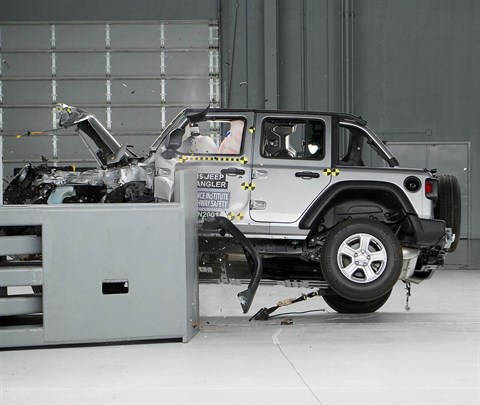
Action shot taken during the second of two Institute-conducted driver-side small overlap frontal crash tests just before the vehicle tipped on its side.

The dummy's position in relation to the door frame, steering wheel, and instrument panel after the crash test indicates that the driver's survival space was maintained well (second test shown).

The dummy’s movement was well controlled. The dummy’s head loaded the frontal airbag, which stayed in front of the dummy until rebound. The combination head and torso side airbag deployed but does not have sufficient forward coverage to protect the head from contact with forward side structure and outside objects. The vehicle lacks side curtain airbags (second test shown).

The driver's space was maintained well, and risk of injuries to the dummy's legs and feet was low (second test shown).

The partial rollover presents an additional injury risk beyond what the standard crash test criteria are intended to measure (second test shown).
Moderate overlap front: original test
Rating applies to 2018-24 models
Tested vehicle: 2018 Jeep Wrangler Unlimited Sahara 4-door 4wd
The Jeep Wrangler was redesigned for the 2018 model year. The previous design was built concurrently through much of the same model year and was renamed the Wrangler JK. Moderate overlap frontal ratings are assigned by the Institute based on a test conducted by Fiat Chrysler and apply only to the redesigned model. These ratings also apply to the Jeep Gladiator.
| Evaluation criteria | Rating |
|---|---|
| Overall evaluation | |
| Structure and safety cage | |
| Driver injury measures | |
| Head/neck | |
| Chest | |
| Leg/foot, left | |
| Leg/foot, right | |
| Driver restraints and dummy kinematics | |
Side: original test
Rating applies to 2018-23 models
Tested vehicle: 2019 Jeep Wrangler Unlimited Sport 4-door 4wd
The Jeep Wrangler was redesigned for the 2018 model year. The previous design was built concurrently through much of the same model year and was renamed the Wrangler JK.
| Evaluation criteria | Rating |
|---|---|
| Overall evaluation | |
| Structure and safety cage | |
| Driver injury measures | |
| Head/neck | |
| Torso | |
| Pelvis/leg | |
| Driver head protection | |
| Rear passenger injury measures | |
| Head/neck | |
| Torso | |
| Pelvis/leg | |
|
Rear passenger head protection
The dummy's head was hit by the soft top vertical support and rear door window frame. This impact did not produce high head injury measures, but the head protection is insufficient. | |
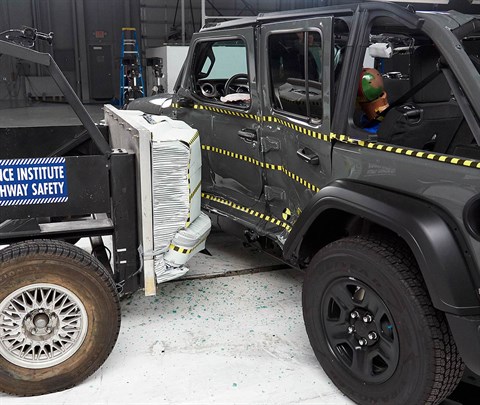
View of the vehicle and barrier just after the crash test.
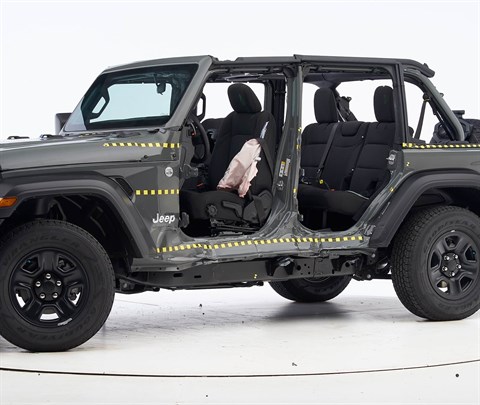
View of the vehicle after the crash with doors removed, showing the driver side airbag and damage to the occupant compartment.
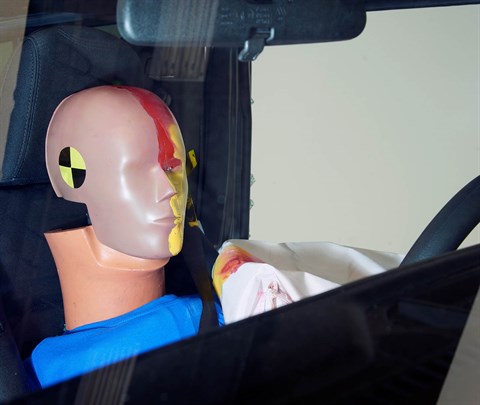
Smeared greasepaint shows where the driver dummy's head was protected from being hit by hard structures by the combination head and torso side airbag.
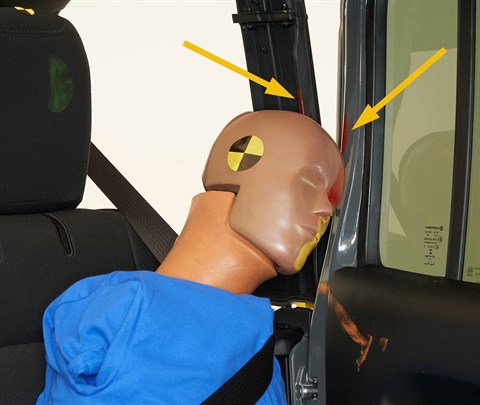
Smeared red greasepaint shows where the rear passenger dummy’s head was hit by the soft top vertical support and rear door window frame.
Side: updated test
Rating applies to 2018-23 models
Tested vehicle: 2021 Jeep Wrangler Unlimited Sport 4-door 4wd
The Jeep Wrangler was redesigned for the 2018 model year. The previous design was built concurrently through much of the same model year and was renamed the Wrangler JK. These ratings also apply to the Jeep Gladiator, introduced in the 2021 model year.
| Evaluation criteria | Rating |
|---|---|
| Overall evaluation | |
| Structure and safety cage | |
| Driver injury measures | |
| Head/neck | |
| Torso | |
| Pelvis | |
| Driver head protection | |
| Rear passenger injury measures | |
| Head/neck | |
| Torso | |
| Pelvis | |
|
Rear passenger head protection
The dummy's head contacted the soft top vertical support and rear door window frame. The head protection is inadequate. | |
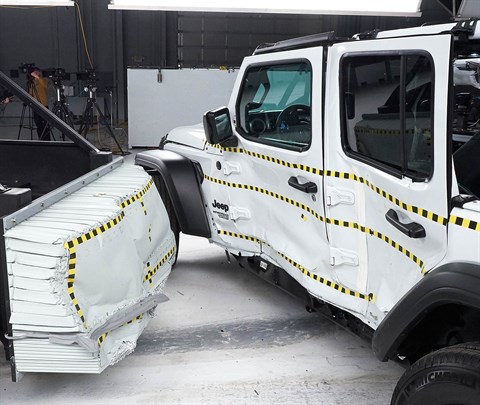
View of the vehicle just after the crash test.

View of the vehicle after the crash with doors removed, showing the driver side airbag and damage to the occupant compartment.
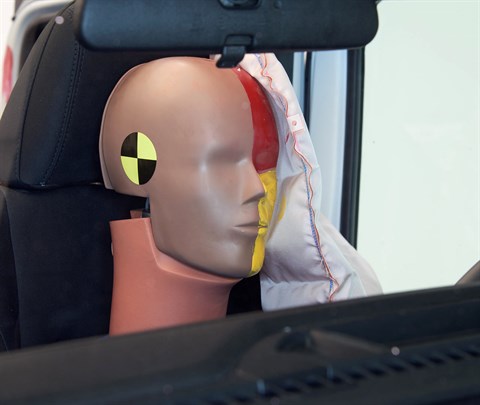
Smeared greasepaint shows where the driver dummy's head was protected from being hit by hard structures by the combination head and torso side airbag.

Smeared red greasepaint shows where the rear passenger dummy's head struck the rear door window frame.
Roof strength
Rating applies to 2018-23 models
Tested vehicle: 2019 Jeep Wrangler Unlimited Sport 4-door 4wd
Roof ratings do not apply to the Wrangler JK
| Overall evaluation | |
|---|---|
| Curb weight | 4,239 lbs |
| Peak force | 22,622 lbs |
| Strength-to-weight ratio | 5.34 |
Head restraints & seats
Seat type: Manual cloth seat
| Overall evaluation | |
|---|---|
| Dynamic rating | |
| Seat/head restraint geometry |
About the head restraint & seat test
Currently, IIHS tests apply only to front seats.
Headlights
Ratings are given for 2 different headlight variations available on this vehicle.
Trim level(s)
- Sahara trim equipped with LED Lighting Group package
- Rubicon trim equipped with LED Lighting Group package
- Sahara Altitude trim equipped with LED Lighting Group package
- Moab trim
| Evaluation criteria | Rating |
|---|---|
| Low-beam headlight type | LED projector |
| High-beam headlight type | LED projector |
| Curve-adaptive? | No |
| High-beam assist? | No |
|
Overall rating | |
| Distance at which headlights provide at least 5 lux illumination: | |
Low beams
On the straightaway, visibility was fair on the left side of the road and inadequate on the right side. On curves, visibility was good on both right curves, fair on the sharp left curve and inadequate on the gradual left curve.
The low beams created some glare.
High beams
On the straightaway, visibility was inadequate on both sides of the road. On curves, visibility was fair on both right curves and inadequate on both left curves.
Trim level(s)
- Sport trim
- Sport S trim
- Sport Altitude trim
- Sahara trim
- Rubicon trim
- Sahara Altitude trim
| Evaluation criteria | Rating |
|---|---|
| Low-beam headlight type | Halogen reflector |
| High-beam headlight type | Halogen reflector |
| Curve-adaptive? | No |
| High-beam assist? | No |
|
Overall rating | |
| Distance at which headlights provide at least 5 lux illumination: | |
Low beams
On the straightaway, visibility was inadequate on both sides of the road. On curves, visibility was inadequate in all 4 tests.
The low beams never exceeded glare limits.
High beams
On the straightaway, visibility was fair on the right side of the road and inadequate on the left side. On curves, visibility was inadequate in all 4 tests.
Front crash prevention: vehicle-to-vehicle
Child seat anchors
Rating applies to 2018-25 models
| Evaluation criteria | Rating |
|---|---|
| Overall evaluation | + extra LATCH positions |
| Vehicle trim | Unlimited Sport |
| Seat type | cloth |
This vehicle has 2 rear seating positions with complete child seat attachment (LATCH) hardware.
It has 1 additional seating position with a tether anchor and the ability to borrow lower anchors from the other seating positions.
Note: When anchors are borrowed, they aren't available to use in their designated positions.
| Evaluation criteria | Rating |
|---|---|
| Overall evaluation | + extra LATCH positions |
| Vehicle trim | Unlimited Sport |
| Seat type | cloth |
| Rating icon | Rating |
|---|---|
| G | Good |
| A | Acceptable |
| M | Marginal |
| P | Poor |
| Seating positions that rely on borrowed lower anchors or have only a tether anchor available are not rated. | |
thether anchor symbol | Tether anchor |
lower anchor symbol | Lower anchors |
| Lower anchor(s) can be borrowed from adjacent positions(s) | |
| No hardware available |
Details by seating position
| Position | Rating |
|---|---|
| 1 | |
| Tether anchor | |
| easy-to-find location | |
| no other hardware could be confused for anchor | |
| Lower anchors | |
| not too deep in seat | |
| not too much force needed to attach | |
| easy to maneuver around anchors | |
| 2 | |
| Tether anchor | |
| easy-to-find location | |
| no other hardware could be confused for anchor | |
| Lower anchors | |
| Can be borrowed from 1 and 3 | |
| 3 | |
| Tether anchor | |
| easy-to-find location | |
| no other hardware could be confused for anchor | |
| Lower anchors | |
| not too deep in seat | |
| not too much force needed to attach | |
| easy to maneuver around anchors |
